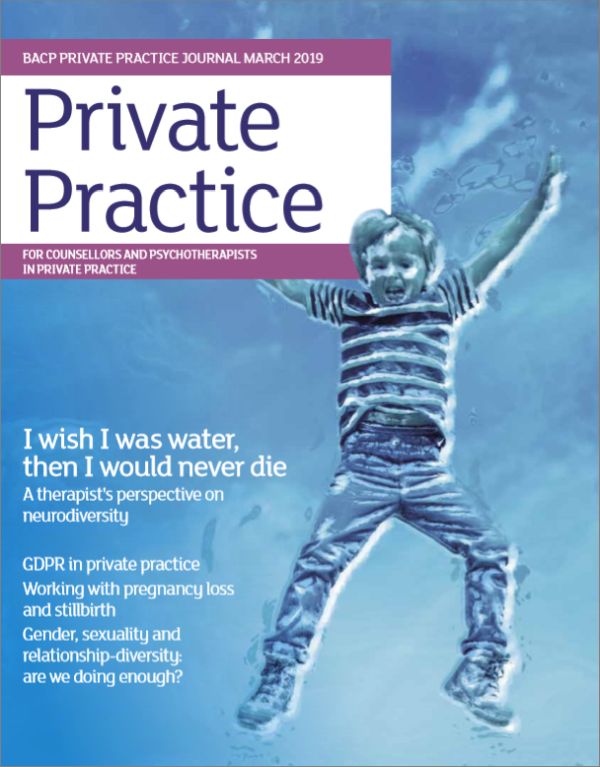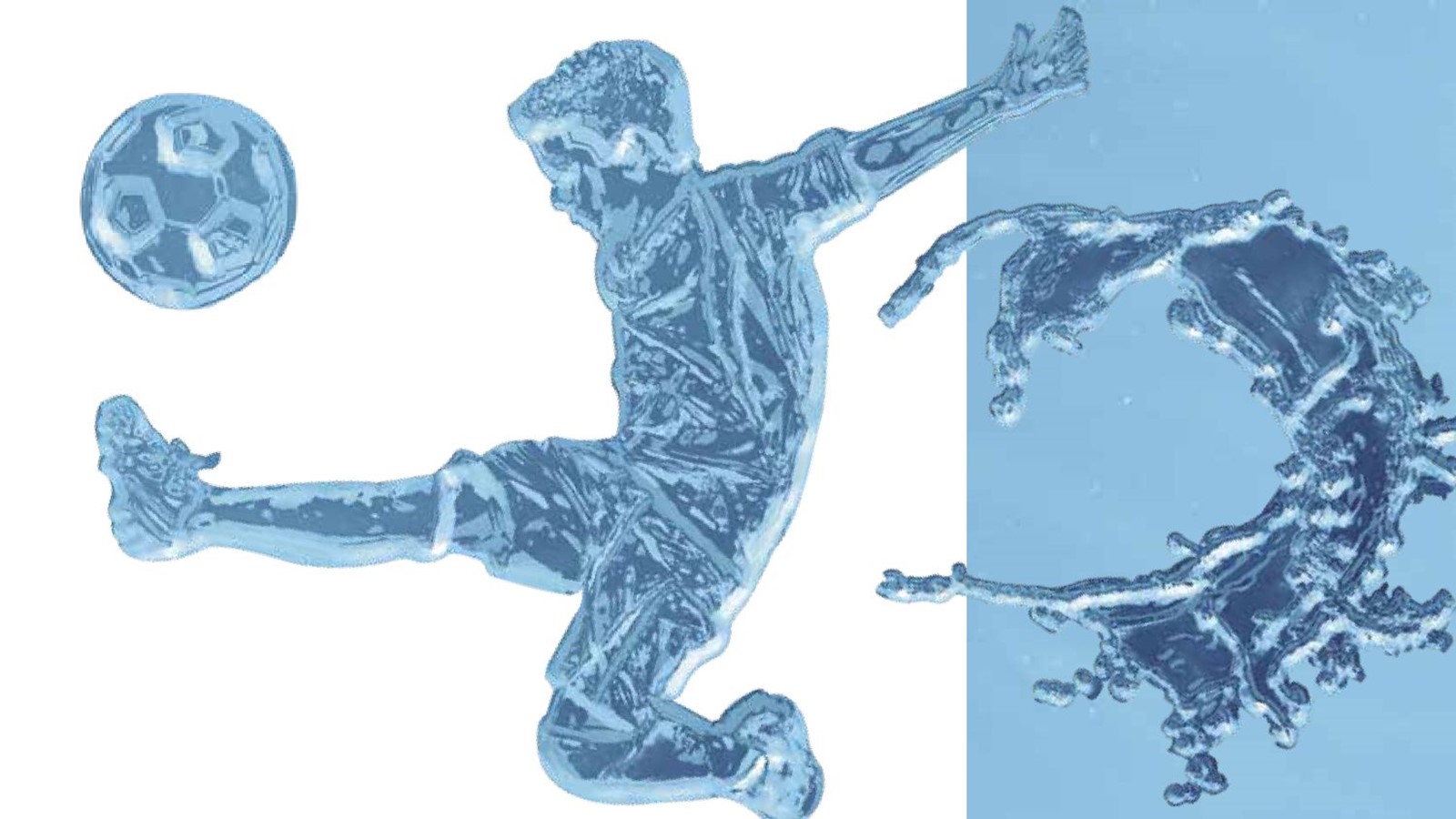In this issue
Features
A most painful delivery
Trudi Dargan on the affect of pregnancy loss and stillbirth
The world and I are within one another
Christopher Tovey on therapy as ‘relational recovery’
I wish I was water, then I would never die (free article)
Neville Tomlinson on neurodiversity
Diversity: are we doing enough?
Laura Baines-Ball on gender, sexually and relationship-diverse clients
Demystifying GDPR (free article)
David Membrey and Barbara Mitchels outline the implications for therapists in private practice
Regulars
From the chair
Lesley Ludlow: Embracing the new
Imperfect therapist
Lizzie Thompson: Too close for comfort
Relationships
Alex Sanderson-Shortt: The sound of silence
Supervision
Jim Holloway: Questioning the edge
My practice
Sarah Van Gogh: Ticking boxes or genuine care

Divisional members and subscribers can download the pdf from the Private Practice archive.
From the editor
These social, political, environmental and economic issues, among many others, affect us all – clients and therapists – and are the context within which we work. This is perhaps most acutely felt at a time, like now, in which complexity, diversity, difference and multiplicity are reduced to crude binaries, and the most provocative views via social media and online news are privileged over nuanced debate.
In his book, Relational Being, Kenneth Gergen argues that societal concerns were central to early therapists, such as Freud, Fromme and Horney, and that they should be no less so today. Christopher Tovey explores Gergen’s concept of therapy as ‘relational recovery’ in his article, ‘The world and I are within one another’. Gergen invites us to view the therapist and client as ‘engaged in a subtle and complex dance of co-action, a dance in which meaning is continuously in motion, and the outcomes of which may transform the relational life of the client’. Further, ‘these relationships are embedded within an expanded array of relations – ethnic, religious, professional, and so on. Therapy is but a single relationship, nesting within a potentially limitless and dynamic complex’.
Reflecting on his work with a client who had been diagnosed as autistic, Tovey remembers trying to bracket his neurotypical assumptions about the social difficulties his client was describing, in order not to experience his autism as a ‘socially defined’ disability: ‘My aim was for us to co-operate, on equal terms, facilitating the process of us working together on the joint project of making sense of his unique relationship with the world and others.’
The theme of entering into our clients’ often very different frames of reference to our own is continued in Neville Tomlinson’s article, ‘I wish I was water, then I would never die’. As the father of two children on the autistic spectrum, and having a partner who, although not officially diagnosed, is almost certainly also on it, Tomlinson grapples with a question he regularly faces in his everyday life: given that the neurotypical world very often makes no sense at all to neurotypicals, how do we explain it to the neurodiverse? By providing a small insight into the world of his family and some of his clients, he hopes to give ‘a different perspective on some of the inaccurate assumptions about the “standard” presentations of those on the autistic spectrum, which are often bandied around with an air of scientific certainty’.
Continuing the diversity theme, Laura Baines-Ball asks if we are doing enough, as practitioners, to explore the thoughts and feelings that arise in us when we work with gender, sexually or relationship-diverse clients, and argues we have to be robust enough to challenge, be challenged and expand our knowledge and understanding. ‘Maybe one of the difficulties with gender, sexual or relationship diversity,’ Baines-Ball writes, ‘is that many therapists now willingly work with this client group, but many also do not have the knowledge and language to give the client the most helpful experience’. For example, ‘When a client identifies as non-binary (outside the male/female gender binary) or trans, and asks to be called by a name, perhaps not the name their parents chose for them, and use a particular pronoun, I do just that. The frustration for me, at times, has been when… [a] supervisor or peer forgets or doesn’t feel comfortable using said pronoun’.
Baines-Ball states: ‘Wherever we have privilege, it can be difficult to see the ways that we “other” those who are different to ourselves. Given that minority stress is a real thing, we need to have the capacity to put ourselves to one side and get into the shoes of those in a different position. It may not make sense to us, but it does make sense to the individual; it’s their experience of the world we are attempting to understand.’
The perspectives outlined in each of these articles give me hope that, in our own small way, through our work as counsellors and psychotherapists, by challenging privilege, prejudice and oppression when we encounter it, by practising personal authenticity and supporting our clients to own theirs, through our respect for others, and awareness of the power dynamics in counselling relationships and in the wider social context, we hold the complexity and inter-relationality of human relationships and resist the currently prevailing primitive impulse to split experience into binaries, extremes and polarities.
Elsewhere in this issue, David Membrey and Barbara Mitchels outline the implications of the General Data Protection Regulation (GDPR) for therapists in private practice and Trudi Dargan reflects on working with clients who have been affected by pregnancy loss and stillbirth.
Finally, don’t forget to mark Saturday 28 September 2019 in your diary as the date of the BACP Private Practice conference, ‘Mind or Body: what’s in charge?’ Keynote speakers will be Professor Alessandra Lemma, who will present on the psychic functions of body modification and Diane Danzebrink, who will speak about the menopause.
John Daniel, Editor
privatepractice.editorial@bacp.co.uk
